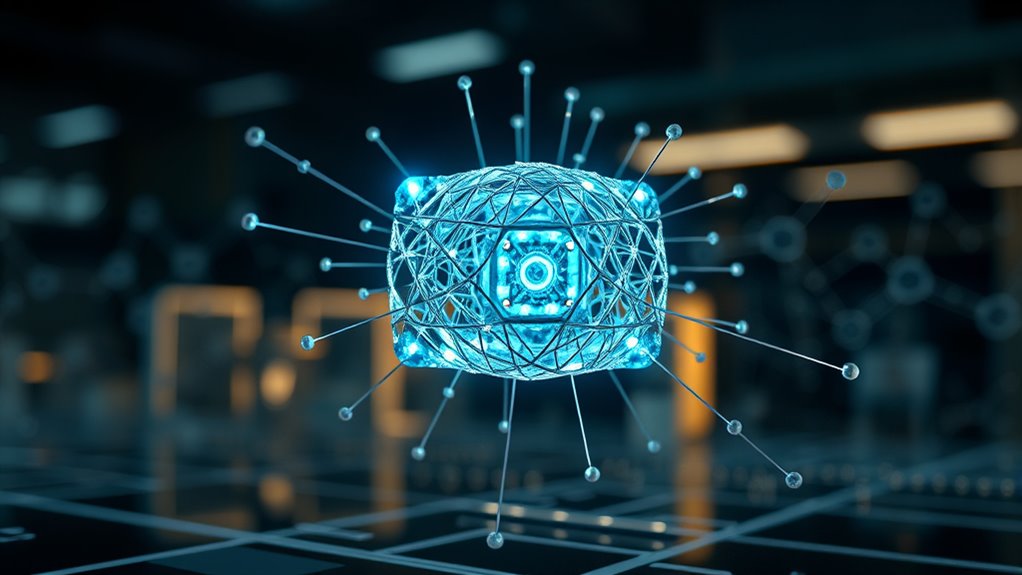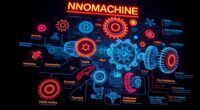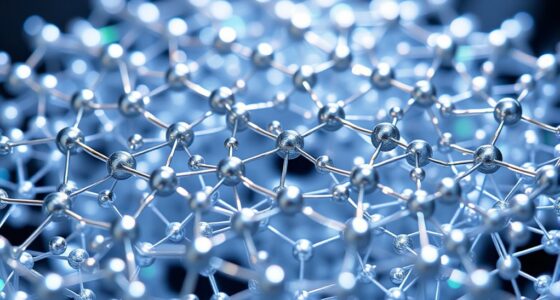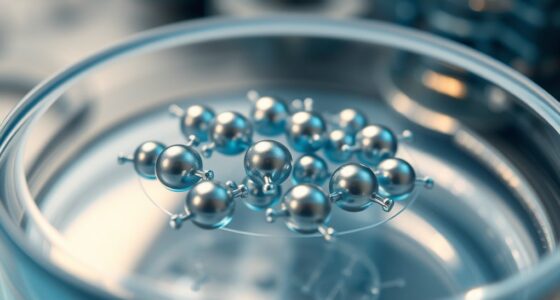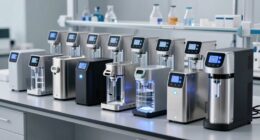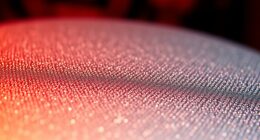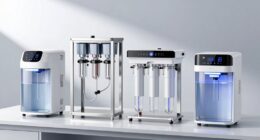Future nanomachines will benefit from breakthroughs in new materials like graphene and advanced fabrication methods, making them more precise and durable. You’ll see increased control over molecules using techniques like atomic force microscopy, combined with artificial intelligence that lets them adapt and learn. However, scaling production and ensuring safety remain challenges. Explore these exciting developments further to understand how emerging technologies could transform medicine, industry, and the environment.
Key Takeaways
- Integration of AI and machine learning enhances nanomachine adaptability, decision-making, and autonomous functionalities.
- Advances in materials like graphene and carbon nanotubes improve nanomachine strength, flexibility, and conductivity.
- Emerging fabrication techniques enable atomic-level precision, reducing errors and increasing scalability.
- Nanomachines will revolutionize medicine, environmental cleanup, and precision manufacturing with targeted, intelligent functionalities.
- Ethical considerations and regulatory development are critical to ensure safe, responsible deployment of nanotechnology.
Breakthroughs in Materials and Fabrication Techniques
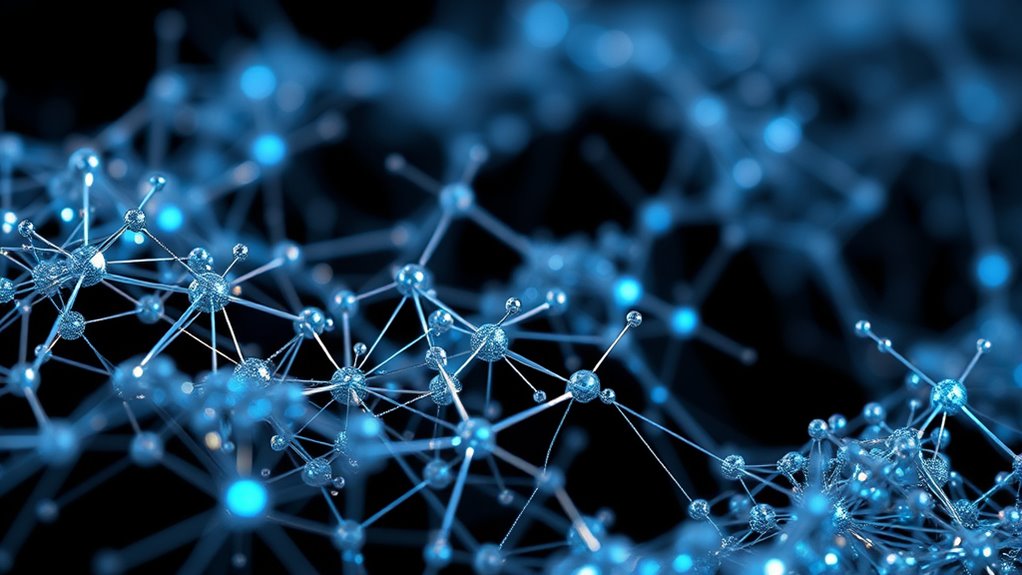
Recent advances in materials and fabrication techniques are revolutionizing how nanomachines are built, making them more precise and functional than ever before. You now have access to novel materials like graphene, carbon nanotubes, and advanced polymers that offer exceptional strength, flexibility, and conductivity at the nanoscale. These materials enable the construction of complex, durable nanomachines capable of performing intricate tasks. Techniques such as atomic layer deposition, electron-beam lithography, and self-assembly allow you to craft structures with atomic-level accuracy. This progress reduces manufacturing errors and enhances device performance. The development of high-precision fabrication methods further ensures that nanomachines can be produced with consistent quality and reliability. As a result, you can design nanomachines with unprecedented precision, opening doors to new applications in medicine, electronics, and environmental sensing. These breakthroughs set the stage for more reliable, efficient, and scalable nanotechnologies.
Advances in Molecular Control and Manipulation

Advances in molecular control and manipulation are enabling you to direct individual atoms and molecules with unprecedented accuracy, transforming the capabilities of nanomachines. You can now precisely position and alter molecules, releasing new possibilities in nanofabrication and biochemical analysis. Techniques like atomic force microscopy and optical tweezers allow you to manipulate matter at the molecular level, creating complex structures atom by atom. This precision enhances your ability to develop customized nanodevices for targeted drug delivery, molecular sensors, and nanoscale assembly lines. As you refine control methods, you gain greater reliability and speed, pushing the boundaries of what nanomachines can achieve. These advancements empower you to explore molecular interactions and design functional nanostructures, laying the foundation for transformative applications across medicine, electronics, and materials science. Mindfulness techniques can also improve focus and precision during delicate manipulations, further advancing your capabilities in this field.
Integration of Artificial Intelligence and Machine Learning
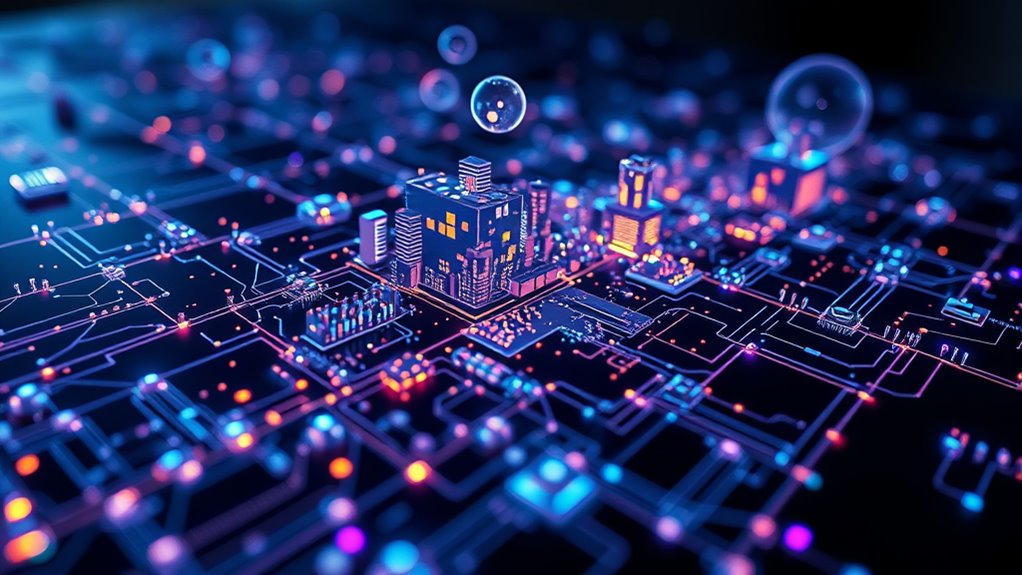
By integrating artificial intelligence and machine learning into nanomachines, you can considerably enhance their ability to adapt, optimize, and perform complex tasks autonomously. These technologies enable nanomachines to analyze environmental data in real-time, make decisions, and adjust their actions without human intervention. This synergy improves precision, efficiency, and functionality across various applications. You can develop nanomachines that learn from their interactions, improving performance over time. Additionally, incorporating sustainable design principles can help minimize environmental impact while maximizing their effectiveness. Below is a table highlighting some key benefits and applications:
| Benefits | Applications |
|---|---|
| Real-time decision-making | Targeted drug delivery |
| Self-optimization | Environmental sensing |
| Enhanced adaptability | Precision manufacturing |
| Autonomous operation | Medical diagnostics |
Challenges in Scalability and Practical Deployment
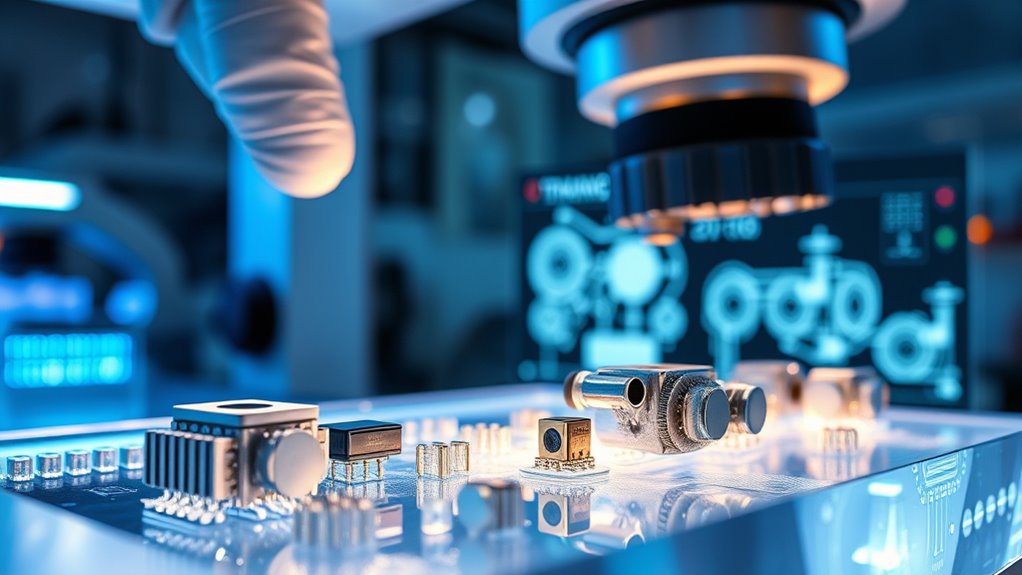
While nanomachines hold great promise for revolutionizing various fields, scaling their production and deployment remains a significant hurdle. Manufacturing nanomachines consistently at large volumes is complex, requiring precise control at atomic levels. Current fabrication methods often lack scalability, making mass production costly and inefficient. Additionally, deploying nanomachines in real-world environments poses challenges, such as ensuring stability, avoiding unintended interactions, and maintaining reliable function over time. You must also consider scalability challenges and integration with existing systems and infrastructure, which can be incompatible or require redesigns. furthermore, regulatory and safety concerns hinder widespread adoption, as testing and standardization processes are still developing. Overcoming these obstacles demands advances in fabrication techniques, rigorous testing protocols, and collaborative efforts across disciplines.
Future Applications and Ethical Considerations

Despite the challenges in scaling production and ensuring safe deployment, nanomachines are poised to transform numerous fields through innovative applications. You could see them revolutionize medicine by targeting cancer cells precisely or repairing tissues at the molecular level. In environmental science, nanomachines might clean pollutants or monitor ecosystems in real time. Additionally, integrating nanomachines with smart devices could enable real-time data collection and improved automation. However, ethical considerations are pivotal. You need to address potential privacy concerns, as nanomachines could collect sensitive data. There’s also the risk of misuse or unintended consequences, such as environmental harm or bioweapons development. Responsible development requires establishing regulatory frameworks, transparency, and public engagement. As you explore these technologies, balancing innovation with safety and ethics becomes essential to maximize benefits while minimizing risks. Your awareness and proactive approach will shape a responsible future for nanomachines.
Frequently Asked Questions
How Will Nanomachines Impact Global Environmental Sustainability?
Nanomachines can profoundly boost global environmental sustainability by cleaning pollutants, reducing waste, and improving resource efficiency. You’ll see them target toxic chemicals in water and air, break down plastics, and optimize energy use in industries. As you support or develop nanotech solutions, you’ll help create cleaner environments, conserve resources, and combat climate change, making a tangible difference for future generations. Their precise, efficient actions make sustainability more achievable.
What Are the Potential Risks of Autonomous Nanomachine Systems?
Autonomous nanomachine systems are like wild animals—you can’t always predict their behavior. They could malfunction, cause unintended environmental damage, or be exploited for malicious purposes. You might also face ethical dilemmas about control and safety, especially if they evolve beyond your oversight. It’s essential to develop strict regulations and safety protocols now, so you can prevent these risks from spiraling out of control in the future.
How Can Nanomachines Be Used in Personalized Medicine?
You can use nanomachines in personalized medicine to target specific cells or tissues, improving treatment precision. They can deliver drugs directly to cancer cells, reducing side effects, or repair damaged tissues at the cellular level. By customizing nanomachines to an individual’s genetic profile, you enhance effectiveness and minimize risks. This approach allows for more tailored therapies, ultimately improving patient outcomes and advancing healthcare toward truly personalized solutions.
What Are the Key Regulatory Hurdles for Nanomachine Deployment?
Think of regulatory hurdles like steering through a maze; they can be complex and confusing. You’ll face challenges such as ensuring safety standards, addressing ethical concerns, and establishing clear testing protocols. Governments and agencies need to develop all-encompassing frameworks to oversee nanomachine development and use. You must also tackle public perception issues and international regulations. Overcoming these obstacles requires collaboration, transparency, and adaptive policies to safely bring nanomachines into practical applications.
How Soon Might Nanomachines Become Commercially Available?
Nanomachines could become commercially available within the next 10 to 20 years, depending on technological advancements and regulatory approvals. You might see them initially in specialized fields like medicine or manufacturing, where their benefits outweigh risks. However, widespread consumer use could take longer, possibly 30 years or more, as safety, ethical concerns, and production costs need to be addressed thoroughly. Staying updated on research progress will help you gauge their arrival.
Conclusion
As you explore the future of nanomachines, remember that each breakthrough is a stepping stone toward transforming countless industries. While technological advances promise incredible possibilities, they also raise ethical questions—like Pandora’s box waiting to be opened. Will you embrace the innovation or tread cautiously? The path ahead is as delicate as the nanomachines themselves, beckoning you to balance progress with responsibility, shaping a future where technology and morality dance in harmony.
